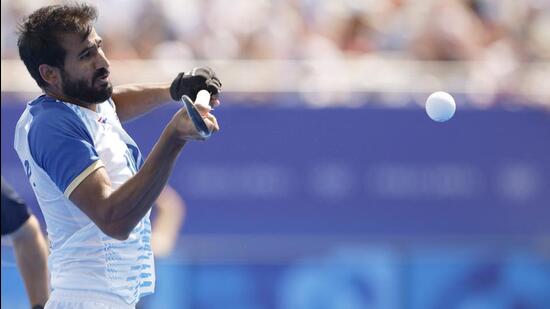Gurjant, India’s all-purpose man upfront
The Paris bronze-winning hockey team’s forward says staying injury free for the past one year has helped him gain confidence of the coach, team
Harmanpreet Singh was frequently sounding the board in Paris. But ask the drag-flicker how he ended up as the highest scorer of the Olympics with 10 goals. It was due to the efforts of Gurjant Singh among other forwards who regularly earned the Indian hockey team penalty corners (PC) which were eventually converted by the skipper to earn them a bronze medal at the Olympics.

“It is the mindset of a striker to follow the gameplan, go into the ‘D’ and get an outcome. That is the first responsibility,” says Gurjant, who has 124 India caps.
A native of Khalhera village in Amritsar district, Gurjant is one of the 11 Indian hockey players who have medalled both in Tokyo and Paris. But back then, he wasn’t a regular member of the squad. “That had to do with my injuries,” said the 29-year-old, a product of the Chandigarh Hockey Academy.
Having made his India debut in 2017, Gurjant’s initial years were plagued by injuries which saw him getting in and out of the team.
In early 2019, the Punjab player underwent surgery after his nose took a hit during a practice game in camp which put him out of action for six months. A year later, Gurjant had to go under the knife due to a groin injury and sports hernia, again putting him out of action for five months. Once he returned after winning the bronze in Tokyo, Gurjant needed to undergo rehabilitation due to a hip injury he suffered in Japan.
“I missed many tournaments due to these injuries. Once you are out of the team, it is very difficult and takes a lot of effort to return, perform and settle back into the team,” added Gurjant. “On return, you have to compete against a player who has taken your position and prove to your coach that you are injury free and better.”
Fortunately, Gurjant has been injury free since his return to the squad in March 2022. Known for his poaching skills, he has gained the trust of chief coach Craig Fulton, who has a lot of belief in Gurjant’s skills. “Yes, I have been playing continuously for the last one-and-a-half years. When you play continuously, your responsibility increases and so does your confidence. You know that the team and the coach trust you. You feel you’re an important member of the team,” adds Gurjant, who comes from a family of farmers.
Under Fulton, Gurjant’s role has also changed. While in Tokyo, Gurjant was an out-and-out forward, his role kept switching from the forward line to the attacking midfield in Paris depending on the situation of the game.
“Under Craig, I am playing as a midfielder as well as a striker. With only 16 players at the Olympics, he wanted players who could play in different positions in case there are injuries in which case you should be ready to play in a different role so that it doesn’t affect the game,” Gurjant said.
Such a situation did arise when defender Amit Rohidas was suspended for the semi-final against Germany after receiving a red card in the last-eight clash versus Great Britain. “If need arises a forward should be able to play in the midfield while a midfielder should be able to play in defence. We tried it out in Pro League games where I played some matches as midfielder and some in the forward line,” said Gurjant, who substituted positions with Raj Kumar Pal and Shamsher Singh in either attacking midfield or the forward line in Paris.
The plans worked, the efforts bore fruit as Gurjant along with 15 other teammates helped India win a second successive Olympic medal for the first time in 52 years. “It feels nice to win a second Olympic medal. Every player first dreams of playing for the country and then winning an Olympic medal,” said Gurjant.





